|
11 - A SPACE BASE ON
MARS
Having been to the Moon, Earthlings are eager to set foot on
Mars.
It was on the occasion of the twentieth anniversary of the first
landing by Man on the Moon that the President of the United States
outlined his country’s stepping stones to Earth’s nearest outer
planet. Speaking at the National Air and Space Museum in Washington
and flanked by the three Apollo 11 astronauts—Neil A. Armstrong,
Edwin E. Aldrin, Jr., and Michael Collins—President George Bush
outlined America’s way stations to Mars. First, progress from the
shuttlecraft program to the emplacement in permanent Earth orbit of
a Space Station, where the larger vehicles necessary for the onward
flights would be assembled.
Then would come the establishment of a
space base on the Moon, where materials, equipment, and fuels
necessary for the long space voyages would be developed and tested,
and experience would be gained in Man’s living and working for
extended periods in outer space. And finally, the actual expedition
to Mars, Vowing to make the United States “a spacefaring nation,”
the goal, the President said, will be “back to the Moon, back to the
future . . . and then, a journey into tomorrow, to another planet: a
manned mission to Mars.”
“Back to the future.” The choice of words may or may not have been
coincidental; the premise that going to the future involves going
back to the past might have been more than a speech writer’s choice
slogan.
For there is evidence that “A Space Base on Mars,” this
chapter’s heading, should apply not to the discussion of future
plans but to a disclosure of what has already taken place in
the past: Evidence that a space base existed on the planet Mars
in antiquity; and what is even more startling, that it might have
been reactivated before our very eyes. If Man is to venture from
planet Earth into space, it is only logical and technologically
called for to make Mars the first planet on the outbound voyage. The
road to other worlds must have way stations due to the laws of
celestial motion, the constraints of weight and energy, the
requirements for human survival, and limitations on human physical
and mental endurance.
A spaceship capable of carrying a team of
astronauts to Mars and back might have to weigh as much as four
million pounds. Lifting such a massive vehicle off the surface of
Earth (a planet with a substantial gravitational pull, compared with
its immediate neighbors) would require a commensurately large load
of fuel that, together with the tanks to hold it, would further
increase the lift-off weight and make the launch impractical. (U.S.
space shuttles now have a payload capacity of sixty-five thousand
pounds.)
Such lift-off and fuel problems would be greatly reduced if the
spaceship will be assembled in weightless orbit around the Earth.
This scenario envisions an orbiting, manned space station, to which
shuttle craft will ferry the knocked-down spaceship. Meanwhile,
astronauts stationed on the Moon at a permanent space base would
develop the technology required for Man’s survival in space. Man and
vehicle would then be joined for the voyage to Mars.
The round trip may take between two and three years, depending on
the trajectory and Earth-Mars alignments. The length of stay on Mars
will also vary according to these constraints and other
considerations, beginning with no stay at all (just several orbits
around Mars) to a long stay in a permanent colony served or
sustained by shifts of spacecraft and astronauts. Indeed, many
advocates of “The Case for Mars,” as this approach has come to be
called after several scientific conferences on the subject, consider
a manned mission to Mars justified only if a permanent space base is
established there, both as a prelude to manned missions to even more
distant planets and as the forerunner of a colony, a permanent
settlement of Earthlings on a new world.
The progression from shuttlecraft to an orbiting space station to
landings on the Moon and the establishment of a space base thereon, all as stepping-stones or way stations
toward a landing on Mars, has been described in scenarios that read
like science fiction but are based on scientific knowledge and
attainable technology. Bases on the Moon and on Mars, even a colony
on Mars, have been in the planning for a long time and are deemed
entirely feasible. Sustaining human life and activity on the Moon is
certainly challenging, but the studies show how it could be
achieved. The tasks are more challenging for Mars, since resupply
from Earth (as the Moon projects envision) is more difficult and
costly. Nevertheless, the vital resources needed by Man to survive
and function are available on Mars, and scientists believe that Man
could live “off the land” there. Mars, it has been concluded, is
habitable—because it was habitable in the past.
Mars appears nowadays as a cold, half-frozen planet inhospitable to
anything living upon its surface, with bitter-cold winters and
temperatures rising above freezing only at the equator in the
warmest season, with vast areas covered either with permafrost or
with rusted iron rocks and gravel (which give the planet its reddish
hue), with no liquid water to sustain life or oxygen to breathe. But
not so long ago in geological terms, it was a planet with relatively
pleasant seasons, flowing water, oceans and rivers, cloudy (blue!)
skies, and perhaps—just perhaps—even some forms of indigenous simple
plant life.
All the various studies converge toward the conclusion that
Mars is now going through an ice age, not unlike the ice ages
that Earth has experienced periodically. The causes of Earth’s
ice ages, attributed to many factors, are now believed to stem
from three basic phenomena that relate to Earth’s orbit around
the Sun. The first is the configuration of the orbit itself: the
orbit, it has been concluded, changes from more circular to
more elliptical in a cycle of about one hundred thousand years;
this brings the Earth at times closer to the Sun and at times
farther away from it.
Earth has seasons because the axis of
Earth is not perpendicular to its orbital plane (ecliptic) but is
tilted, bringing the northern hemisphere under a stronger influence
of the Sun’s rays during the (northern) summer (during
winter in the southern hemisphere), and vice versa (Fig. 73);
but this tilt, now about 23.5 degrees, is not stable; the Earth,
like a rolling ship, changes its tilt by about 3 degrees back and
forth in a cycle that takes about forty-one thousand years to
complete.
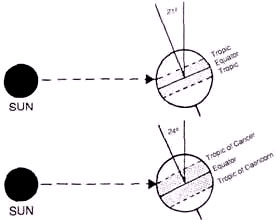
Figure 73
The greater the tilt the more extreme are the winters and
summers; air and water flows change and aggravate the climatic
changes that we call “ice ages” and “ interglacial” warm periods. A
third contributing cycle is that of the Earth’s wobble as it spins,
its axis forming an imaginary circle in the heavens; this is the
phenomenon of Precession of the Equinoxes, and the duration of this
cycle is about twenty-six thousand years.
The planet Mars is also subject to all three cycles, except that its
larger orbit around the Sun and greater tilt differential cause more
extreme climatic swings. The cycle, as we have mentioned, is
believed to last some fifty thousand years on Mars (although shorter
and longer durations have also been suggested).
When the next Martian warm period, or interglacial, arrives, the
planet will literally flow with water, its seasons will not be as harsh, and its atmosphere will not be as
alien to Earthlings as it is today. When was the last “interglacial”
epoch on Mars? The time could not have been too distant, because
otherwise the dust storms on Mars would have obliterated more, if
not most, of the evidence on its surface of once flowing rivers,
ocean shorelines, and lake basins; and there would not be as much
water vapor still in the Martian atmosphere as is found today.
“Running water must have existed on the red planet in relatively
recent times, geologically speaking,” according to Harold Masursky
of the U.S. Geological Survey.
Some believe the last change occurred
no more than ten thousand years ago.
Those who are planning the landings and extended stays on
Mars do not expect the climate there to revert to an interglacial
epoch within the next two decades; but they do believe that
the basic requirements for life and survival on Mars are locally
available. Water, as has been shown, is present as permafrost
in vast areas and could be found in the mud of what from space
appear to be dry riverbeds. When geologists at Arizona State
University working for NASA were suggesting Mars landing
sites to Soviet scientists, they pointed to the great canyon in
the Lunae Planum basin as a place where a roving vehicle
“could visit former riverbeds and dig into the sediments of a
delta where an ancient river flowed into a basin,” and find
there liquid water.
Aquifers—subterranean water pools—are
a sure source of water in the opinion of many scientists. New
analyses of data from spacecraft as well as from Earth-based
instruments led a team headed by Robert L. Huguenin of the
University of Massachusetts to conclude, in June 1980, that
two concentrations of water evaporation on Mars south of its
equator suggest the existence of vast reservoirs of liquid water
just a few inches below the Martian surface. Later that year
Stanley H. Zisk of the Haystack Observatory in Westford,
Massachusetts, and Peter J. Mouginis-Mark of Brown University,
Rhode Island, reported in Science and Nature (November
1980) that radar probing of areas in the planet’s
southern hemisphere indicated “moist oases” of “extensive
liquid water” beneath the surface.
And then, of course, there
is all the water captured in the ice cap of the northern pole,
which melts around its rims during the northern summer, creating
large, visible darkish patches (Fig. 74).

Figure 74
Morning fogs
and mists that have been observed on Mars suggest to scientists the
existence of dew, a source of water for many plants and animals on
Earth in arid areas.
The Martian atmosphere, at first sight inhospitable and even
poisonous to Man and life, could in fact be a source of vital
resources. The atmosphere has been found to contain some water
vapor, which could be extracted by condensation. It could also be a
source of oxygen for breathing and burning. It consists on Mars
primarily of carbon dioxide (CO2) with small
percentages of nitrogen, argon, and traces of oxygen (Earth’s
atmosphere consists primarily of nitrogen, with a large percentage
of oxygen and small amounts of other gases).
The process of
converting carbon dioxide (C02) to carbon monoxide (CO), thereby
releasing oxygen (CO + O) is almost elementary and could easily be
performed by astronauts and settlers. Carbon monoxide can then serve
as a simple rocket fuel. The planet’s reddish-brown, or “rusty,” hue
is also a clue to the availability of oxygen, for it is the result
of the actual rusting of iron rocks on Mars.
The product is iron
oxide—iron that has combined with oxygen. On Mars it is of a type
called limonite, a combination of iron oxide (Fe2O3) with several
molecules of water (H2O); with the proper equipment, the plentiful
oxygen could be separated and extracted. The hydrogen obtainable by
breaking down water into its component elements could be used in the
production of foods and useful materials, many of which are based on
hydrocarbons {hydrogen-carbon combinations).
Although the Martian soil is relatively high in salts, scientists
believe it could be washed with water sufficiently to the point
where patches would be suitable for plant cultivation in
greenhouses; local foods could thus be grown, especially from seeds
of salt-resistant strains of grains and vegetables; human waste
could be used as fertilizer, as it is used in many Third World
countries on Earth. Nitrogen, needed by plants and fertilizers, is
in short supply on Mars but not absent: the atmosphere, though 95
percent carbon dioxide, does contain almost 3 percent nitrogen. The
greenhouses for growing all this food would be made of inflatable
plastic domes; electricity would be obtained from solar-powered
batteries; the rover vehicles will also be solar-powered.
Another source not just of water but also of heat on Mars is
indicated by the past volcanic activity there. Of several notable
volcanoes, the one named Olympus, after the Greek mountain of the
gods, dwarfs anything on Earth or even in the Solar System. The
largest volcano on Earth, Mauna Loa in Hawaii, rises 6.3 miles;
Olympus Mons on Mars towers 15 miles above the surrounding plain;
its crater’s top measures 45 miles across. The volcanoes of Mars and
other evidence of volcanic activity on the planet indicate a hot
molten core and thus the possible existence
of warm surface spots, hot-water springs, and other phenomena
resulting from internally generated heat.
With a day almost exactly the length of a day on Earth, seasons
(although about twice as long as Earth’s), equatorial regions, icy
northern and southern poles, water resources that once were seas and
lakes and rivers, mountain ranges and plains, volcanoes and canyons,
Mars is Earthlike in so many ways. Indeed, some scientists believe
that Mars, although created at the same time as the other planets
4.6 billion years ago, is at the stage Earth was at its beginnings,
before plant life began to emit oxygen and change Earth’s
atmosphere.
This notion has served as a basis for the suggestion by
proponents of the Gaia Theory of how Man might “jump the gun” on
Martian evolution by bringing life to it; for they hold that it was
Life that made Earth hospitable to life. Writing in The Greening of
Mars, James Lovelock and Michael Allaby employed science fiction to
describe how microorganisms and “halocarbon gases” would be sent
from Earth to Mars in rockets, the former to start the biological
chain and the latter to create a shield in the Martian atmosphere.
This shield of halocarbon gases, suspended in the atmosphere above
the now cold and arid planet, would block the dissipation into space
of the warmth Mars receives from the Sun and its own internal heat
and would create an artificially induced “greenhouse” effect.
The
warming and the thickened atmosphere would release Mars’s frozen
waters, enhance plant growth, and thereby increase the planet’s
oxygen supply. Each step in this artificially induced evolution
would strengthen the process; thus will the bringing of Life to Mars
make it hospitable to life. The suggestion by the two scientists
that the transformation of Mars into a habitable planet—they called
the process “Terra forming”—should begin with the creation of an
artificial shield to protect the planet’s dissipating heat and water
vapor by artificially suspending a suitable material in the planet’s
atmosphere was made by them in 1984.
Whether by coincidence or not, it was once again a case of modern
science catching up with ancient knowledge. For, in
The I2th Planet
(1976), it was described how the Anunnaki came to Earth about
450,000 years ago in order to obtain gold—needing the metal to protect life on their planet Nibiru by
suspending gold particles as a shield in its dwindling atmosphere,
to reverse the loss of heat, air, and water.
The plans proposed by the advocates of
the Gaia Hypothesis are based
on an assumption and a presumption. The first, that Mars does not
have life-forms of its own; the second, that people from one planet
have the right to introduce their lifeforms to another world,
whether or not it has its own life. But does Mars have life on it or
as some prefer to ask, did it have life on it in its less harsh
epochs? The question has preoccupied those who have planned and
executed the various missions to Mars; and after all the scanning
and photographing and probing, it is evident that Life as it has
blossomed on Earth—trees and forests, bushes and grasses, flying
birds and roaming animals—is just not there. But what about lesser
lifeforms—lichens or algae or the lowly bacteria?
Although Mars is much smaller than Earth (its mass is about a tenth
that of Earth, its diameter about half) its surface, now all dry
land, is about the same area as the dry-land portion of Earth’s
surface. The area to be explored is thus the same as the area on
Earth with all its continents, mountains, valleys, equatorial and
polar zones; its warm and the cold places; its humid regions and the
dry desert ones. When an outline of the United States, coast to
coast, is superimposed on the face of Mars (Fig. 75), the scope of
the exploration and the variety of terrains and climates to contend
with can well be appreciated.
No wonder when then that the first successful unmanned
Mars probes. Mariners 4, 6, and 7 (1965-69), which photographed
parts of the planet’s surface in the course of flybys,
revealed a planet that was heavily cratered and utterly desolate,
with little sign of any geologic activity in its past. As it
happened,
the pictures were almost all of the cratered highlands
in the southern hemisphere of Mars.
This image, of a planet
not only without life on it but itself a lifeless and dead globe,
changed completely when Manner 9 went into orbit around
Mars in 1971 and surveyed almost its entire surface. It showed
a living planet with a history of geologic activity and volcanism,
with plains and mountains, with canyons in which America’s
Grand Canyon could be swallowed without a trace, and
the marks of flowing water. It was not only a living planet but one
that could have life upon it.
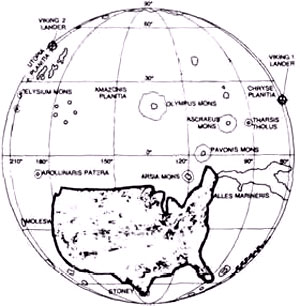
Figure 75
The search for life on Mars was thus made a prime objective of the
Viking missions. Viking 1 and Viking 2 were launched from Cape
Canaveral in the summer of 1975 and reached their destination in
July and August of 1976. Each consisted of an Orbiter that remained
in orbit around the planet for ongoing observation, and of a Lander
that was lowered to the planet’s surface. Although to ensure safe
landings, relatively flat sites in the northern hemisphere, not too
distant from each other, were selected for the touchdowns,
“biological criteria” (i.e., the possibility of life) “dominated the
decision regarding the latitude at which the spacecraft would land.”
The orbiters have provided a rich array of data about Mars that is
still being studied and analyzed, with new details and insights
constantly emerging; the landers sent
thrilling photographs of the Martian landscape at very close range
and conducted a series of experiments in search of Life.
Besides instruments to analyze the atmosphere and cameras to
photograph the areas in which they touched down, each Lander carried
a combined gas-chromatograph/mass-spectrometer for analyzing the
surface for organic material, as well as three instruments designed
to detect metabolic activity by any organism in the soil. The soil
was scooped up with a mechanical arm, put into a small furnace,
heated, and otherwise treated and tested. There were no living
organisms in the samples; only carbon dioxide and a small amount of
water vapor were found.
There were not even the organic molecules
that impacting meteorites bring with them; the presumption is that
if such molecules had been delivered to Mars, the present high level
of ultraviolet light that strikes the planet, whose protective
atmosphere is now almost gone, must have destroyed them. During the
long days of experiments on Mars, drama and excitement were not
absent. In retrospect the ability of the NASA team to manipulate and
direct from Earth equipment on the surface of Mars seems like a
fairy tale; but both planned routines and emergencies were adroitly
tackled. Mechanical arms failed to work but were fixed by radio
commands.
There were other malfunctions and adjustments. There was
breathtaking suspense when the gas-exchange experiments detected a
burst of oxygen; there was the need to have Viking 2 instruments
confirm or disprove the results of experiments carried out by those
of Viking 1 that left open the question of whether changes in the
scooped-up soil samples were organic or chemical, biological or
inanimate. Viking 2 results confirmed the reactions of Viking 1
experiments: when gases were mixed or when soil was added to a
“nutrient soup,” there were marked changes in the level of carbon
dioxide; but whether the changes represented a chemical reaction or
a biological response remained a puzzle.
As eager as scientists were to find life on Mars, and thereby find
support for their theories of how life on Earth began spontaneously
from a primordial soup, most had to conclude regretfully that no
evidence of life on Mars was found. Norman Horowitz of Caltech
summed up the prevailing opinion when he
stated (in Scientific American, November 1977) that,
“at least those
areas on Mars examined by the two spacecraft are not habitats of
life. Possibly the same conclusion applies to the entire planet, but
that is an intricate problem that cannot yet be addressed.”
In subsequent years, in laboratory experiments in which the soil and
conditions on Mars were simulated as best as the researchers could,
the reactions indicated biological responses. Especially intriguing
were experiments conducted in 1980 at the Space Biology Laboratory
of Moscow University: when Earthly life-forms were introduced into a
simulated Martian environment, birds and mammals expired in a few
seconds, turtles and frogs lived many hours, insects survived for
weeks—but fungi, lichens, algae, and mosses quickly adapted
themselves to the new environment; oats, rye, and beans sprouted and
grew but could not reproduce. Life, then, could take hold on Mars;
but had it?
With 4.6 billion years at the disposal of evolution on
Mars, where are not merely some microorganisms (which may or may not
exist) but higher life-forms? Or were the Sumerians right in saying
that life sprouted on Earth so soon after its formation only because
the “Seed of Life” was brought to it, by Nibiru? While the soil of
Mars still keeps its riddle of whether or not its test reactions
were chemical and lifeless or biological and caused by living
organisms, the rocks of Mars challenge us with even more enigmatic
puzzles.
One can begin with the mystery of Martian rocks found not on Mars
but on Earth. Among the thousands of meteorites found on Earth,
eight that were discovered in India, Egypt, and France between 1815
and 1865 (known as the SNC group, after the initials of the sites’
names) were unique in that their age was only 1.3 billion years,
whereas meteorites are generally 4.5 billion years old. When several
more were discovered in Antarctica in 1979, the gaseous composition
of the Martian atmosphere was already known; comparisons revealed
that the SNC meteorites contained traces of isotopic Nitrogen-14,
Argon-40 and 36, Neon-20, Krypton-84, and Xenon-13 almost identical
to the presence of these rare gases on Mars.
How did these meteorites or rocks reach Earth? Why are
they only 1.3 billion years old? Did a catastrophic impact on
Mars cause them to somehow defy its gravity and fly off to Earth?
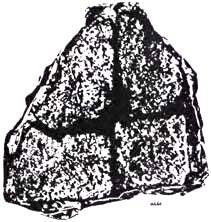
Figure 76
The rocks discovered in Antarctica are even more puzzling. A
photograph of one of them, released by NASA and published in
The New
York Times of September 1, 1987, shows it to be not “football sized”
as these rocks had been described, but rather a broken-off block
(Fig. 76) of four bricklike, artificially shaped and angled stones
fitted together—something one would expect to find in pre-Inca ruins
in Peru’s Sacred Valley (Fig. 77) but not on Mars.
Yet all tests on
the rock (it is no longer referred to as a meteorite) attest to its
Martian origin. To compound the mystery, photographs of the Martian
surface have revealed features that, on seeing them, astronomers
dubbed “Inca City.”
Located in the planet’s southern part, they
represent a series of steep walls made up of squarish or rectangular
segments (Fig. 78 is from Mariner-9 photographic frame 4212-15).
John McCauley, a NASA geologist, commented that the “ridges” were
“continuous, show no breaching, and stand out among the surrounding
plains and small hills like walls of an ancient ruin.”

Figure 77

Figure 78
This immense wall or series of connected shaped stone blocks bears a
striking resemblance to such colossal and enigmatic structures on
Earth as the immense wall of gigantic stone blocks that forms the
base of the vast platform at
Baalbek in Lebanon (Fig. 79) or to the
cruder but equally impressive zigzagging parallel stone walls of
Sacsahuaman above Cuzco in Peru (Fig.80).

Figure 79
In The Stairway to Heaven and The Lost Realms, I have
attributed both structures to the Anunnaki/Nefilim. The features
on Mars might perhaps be explained as natural phenomena, and the size of the blocks, ranging from three to five miles in
length, might very well indicate the hand of nature rather than
of people, of whatever provenance. On the other hand, since
no plausible natural explanation has emerged, they might be the
remains of artificial structures—if the “giants’” of Near Eastern
and Andean lore had also visited Mars...

Figure 80
The notion of
“canals” on Mars appeared to have been laid to rest when—after
decades of ridicule—scientists suggested that what Schiaparelli and
Lowell had observed and mapped were in fact channels of dried-up
rivers. Yet other features were found on the Martian surface that
defy easy explanation. These include white “streaks” that run in
straight lines for endless miles—sometimes parallel, sometimes at
angles to each other, sometimes crossing other, narrower “tracks”
(Fig. 81 is a sketched-over photo).
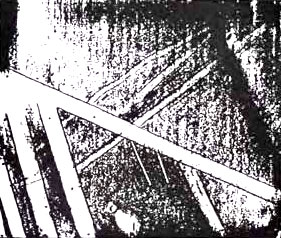
Figure 81
Once again, the NASA teams
suggested that windblown dust storms may have caused these features.
This may be so, although the regularity and especially the
intersecting of the lines seem to indicate an artificial origin.
Searching for a comparable feature on Earth, one must look to the
famous
Nazca lines in southern Peru (Fig. 82) which have been
attributed to “the gods.”

Figure 82
Both the Near East and the Andes are known for their various
pyramids—the immense and unique ones at Giza, the stepped
pyramids or ziggurats of Mesopotamia and of the early American
civilizations.
As pictures taken by the Mariner and Viking
cameras seem to show, even pyramids, or what look like pyramids,
have been seen on Mars.
What appear to be three-sided pyramids in the Elysium (map. Fig. 83)
plateau in the region called Trivium Charontis were first noticed on
Mariner-9 frames 4205-78, taken on February 8, 1972 and 4296-23,
taken six months later.
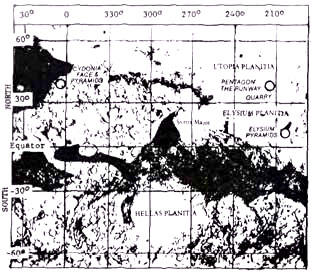
Figure 83
Attention was focused on two pairs of
“tetrahedron pyramidal structures,” to use the cautious scientific
terminology; one pair were huge pyramids, while the other pair were
much smaller, and they seemed to be laid out in a rhombus-shaped
pattern (Fig. 84).
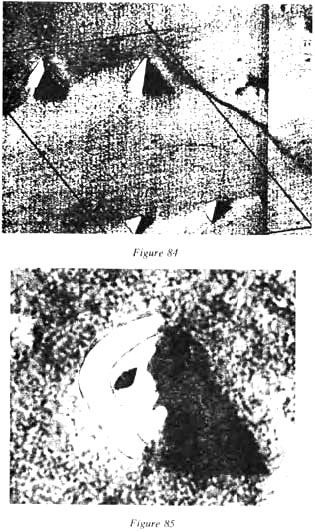
Here again, the size of the “pyramids”—the larger are each
two miles across and half a mile high—suggests that they are
natural phenomena, and a study in the journal Icarus (vol. 22,
1974, by Victor Ablordeppy and Mark Gipson) offered four
theories to explain these formations naturally. David Chandler
(Life on Mars) and astronomer Francis Graham (in Frontiers
of Science, November-December 1980), among others,
showed the flaws in each theory.
The fact that the features
were photographed six months apart, at different sunlights and
angles, and yet show their accurate terrahedral shapes, convinces
many that they are artificial structures, even if we do
not understand the reason for their great size.
“Given the
present lack of any easily acceptable explanation,” Chandler
wrote, “there seems to be no reason to exclude from consideration
the most obvious conclusion of all: perhaps they were built by
intelligent beings.”
And Francis Graham, stating that “the
conjecture that these are buildings of an ancient race of Martians
must take its place among the theories of their origin,” wondered
whether future explorers might discover in these structures inner
chambers, buried entrances, or inscriptions that might have
withstood “ten thousand millennia of wind erosion.”
More “pyramids” with varying numbers of smooth sides
have been discerned by researchers who have scanned the Martian
photographs. Interest, and controversy, have focused
mainly on an area named Cydonia (see map, Fig. 83 above) because
a group of what may be artificial structures appears to be
aligned with what some called a Martian “sphinx” to the east
of these structures, as can be readily seen in the panoramic
NASA photo O35-A-72 (Plate E).
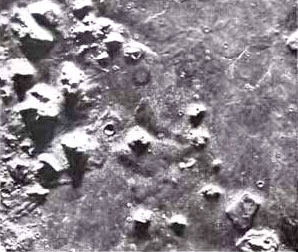
Plate E
What is noticeable is a rock
with the features of a well-proportioned human face, seemingly
of a man wearing some kind of a helmet (Fig. 85 above), with a
slightly open mouth and with eyes that look straight out at the
viewer—if the viewer happens to be in the skies above Mars. Like the
other “monuments”—the features that resemble artificial
structures—on Mars, this one, too, is of large proportions: the Face
measures almost a mile from top to bottom and has been estimated to
rise almost half a mile above the surrounding plateau, as can be
judged by its shadow.
Although it is said that the NASA scientist who examined the
photographs received from the Viking 1 Orbiter on July 25, 1976,
“almost fell out of his chair” when he saw this frame and that
appropriate “Oh, my God” or expressions to that effect were uttered,
the fact is that the photograph was filed away with the thousands of
other Viking photographs without any further action because the
similarity to a human face was deemed just a play of light and
shadows on a rock eroded by natural forces
(water, wind).
Indeed, when some newsmen who happened to see the
transmitted image wondered whether it in fact showed a human face,
the chief scientist of the Mission asserted that another photograph,
taken a few hours later, did not show such a feature at all.
(Years
later NASA acknowledged that that was an incorrect and misleading
statement and an unfortunate one, because the fact was that the area
fell into darkness of night “a few hours later” and there did exist
other photographs clearly showing the Face.)
Three years later
Vincent DiPietro, an electrical engineer and imaging specialist, who
remembered seeing the “Face” in a popular magazine, came
face-to-face with the Martian image as he was thumbing through the
archives of the National Space Science Data Center. The Viking
photo, bearing the catalog number 76-A-593/17384, was simply titled
“HEAD.” Intrigued by the decision to keep the photo in the
scientific data center under that tantalizing caption—the “Head”
whose very existence had been denied—he embarked, together with Greg Molenaar, a Lockheed computer scientist, on a search for the
original NASA image.
They found not one but two, the other being
image 070-A-13 (Plate F). Subsequent searches came up with more
photos of
the Cydonia area taken by different Viking Orbiter cameras
and from both the right and left sides of the features (there are
eleven by now). The Face as well as more pyramidlike and other
puzzling features could be seen on all of them. Using sophisticated
computer enhancement and imaging techniques, DiPietro and Molenaar
obtained enlarged and clearer images of the Face that convinced them
it had been artificially sculpted.
Armed with their findings, they attended the 1981 The Case for Mars
conference but instead of acclaiming them the assembled scientists
cold-shouldered their assertions—undoubtedly because they would have
to draw the conclusion that the Face was the handiwork of
intelligent beings, “Martians” who had inhabited the planet; and
that was a totally unacceptable proposition.
Publishing their findings privately (Unusual Mars Surface
Features) DiPietro and Molenaar took great pains to
dissociate themselves from “wild speculations” regarding the
origin of the unusual features. All they claimed, the book’s
epilogue stated, was “that the features do not seem natural and
warrant further investigation.”
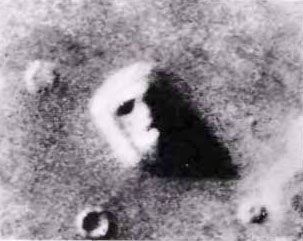
Plate F
NASA scientists, however, strongly
rejected any suggestion that future missions should include a visit
to the Face, since it was clearly just a rock shaped by the forces
of nature so that it resembled a human face.
The cause of the Face on Mars was thereafter taken up primarily by
Richard C. Hoagland, a science writer and onetime consultant at the
Goddard Space Flight Center. He organized a computer conference
titled The Independent Mars Investigation Team with the purpose of
having the features and all other pertinent data studied by a
representative group of scientists and specialists; the group
eventually included Brian O’Leary, a scientist-astronaut, and
David
Webb, a member of the U.S. President’s Space Commission. In their
conclusions they not only concurred with the view that the “Face”
and “pyramids” were artificial structures, they also suggested that
other features on (he surface on Mars were
the handiwork of intelligent beings who had once been on Mars.
I was
especially intrigued by the suggestion in their reports that the
orientation of the Face and the principal pyramid indicated they
were built about half a million years ago in alignment with sunrise
at solstice time on Mars. When Hoagland and his colleague Thomas Rautenberg, a computer specialist, sought my comments on their
photographic evidence, I pointed out to them that the Anunnaki/Nefilim,
according to my conclusions in The 12th Planet, had first landed on
Earth about 450,000 years ago; it was, perhaps, no coincidence that
Hoagland and Rautenberg’s dating of the monuments on Mars coincided
with my timetable. Although Hoagland was careful to hedge his bets,
he did devote many pages in his book The Monuments of Mars to my
writings and to the Sumerian evidence concerning the Anunnaki.
The publicity accorded the findings of DiPietro, Molenaar, and
Hoagland has caused NASA to insist that they were wrong. In an
unusual move, the National Space Flight Center in Greenbelt,
Maryland, which supplies the public with copies of NASA data, has
been enclosing along with the “Face” photographs copies of rebuttals
of the unorthodox interpretations of the images.
These rebuttals
include a three-page paper dated June 6, 1987, by Paul Butterworth,
the Center’s Resident Planetologist. He states that “there is no
reason to believe that this particular mountain, which is similar to
tens of thousands of others on the planet, is not the result of the
natural geological processes which have produced all the other
landforms on Mars. Among the huge numbers of mountains on Mars it is
not surprising that some should remind us of more familiar objects,
and nothing is more familiar than the human face. I am still looking
for the ‘Hand on Mars’ and the “Leg on Mars’!”
“No reason to believe” that the feature is other than natural is, of
course, not a factual argument in disproving the opposite position,
whose proponents contend that they do have reason to believe the
features are artificial structures. Still, it is true that on Earth
there are hills or mountains that give the appearance of a sculpted
human or animal head although they are the
work of nature alone. This, I feel, might well be a valid argument
regarding the “pyramids” on the Elysium plateau or the “Inca City.”
But the Face and some features near it, especially those with
straight sides, remain a challenging enigma.
A scientifically significant study by Mark J. Carlotto, an optics
scientist, was published in the May 1988 issue of the prestigious
journal Applied Optics. Using computer graphic techniques developed
in optical sciences, Carlotto employed four frames from NASA images,
taken by the Viking Orbiter with different cameras during four
different orbits, to recreate a three-dimensional representation of
the Face.
The study provided detailed information about the complex
optical procedures and mathematical formulations of the
three-dimensional analysis, and Carlotto’s conclusions were that
the
“Face” was indeed a bisymmetrical human face, with another eye
socket in the shaded part and a,
“fine structure of the mouth
suggesting teeth.”
These, Carlotto stated, “were facial features and
not a transient phenomenon” or a trick of light and shadow.
“Although the Viking data are not of sufficient resolution to permit
the identification of possible mechanisms of origin for these
objects, the results to date suggest that they may not be natural.””
Applied Optics deemed the study important enough to make it its
front-cover feature, and the scientific journal New Scientist
devoted a special report to the published paper and to an interview
with its author. The journal echoed his suggestion that “at the very
least these enigmatic objects”—the Face and the adjoining pyramidal
features that some had dubbed “The City”—“deserve further scrutiny
by future Mars probes, such as the 1988 Soviet Phobos mission or the
U.S. Mars Observer.”
The fact that the controlled Soviet press has
published and republished articles by Vladimir Avinksy, a noted
researcher in geology and mineralogy, that support the non-natural
origin of the monuments, surely indicates the Soviet aerospace
attitudes on the matter—a subject that will be dealt with at greater
length later on. Noteworthy here are two points made by Dr. Avinsky.
-
He suggests (in published articles and privately delivered papers)
that in considering the enormous size of the Martian formations, one must bear in mind that due to the low
gravity of Mars a man could perform gigantic tasks on it
-
He
attaches great importance to the dark circle that is clearly seen in
the flat area between the Face and the pyramids
While NASA
scientists dismissed it as “a water spot on the lens of the Viking
Orbiter,” Avinsky considers it “the centre of the entire
composition” of the “Martian complex” and its layout (Fig. 86).
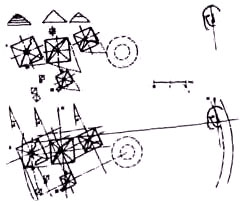
Figure 86
Unless it is assumed that Earthlings possessed, tens of thousands or
even half a million years ago, a high civilization and a
sophisticated technology that enabled them to engage in space
travel, arrive on Mars and, among other things, put up monuments on
it, including the Face, only two other alternatives logically
remain. The first is that intelligent beings had evolved on Mars who
not only could engage in megalithic construction but also happened
to look like us.
But in the absence even of microorganisms in the
soil of Mars, nor evidence of plant and animal life that among other
things could provide the humanlike Martians with nourishment, the
rise of a Martian population akin to
Earthlings and one that even duplicated the structural forms found
on Earth seems highly improbable. The only remaining plausible
alternative is that someone, neither from Earth nor from Mars,
capable of space travel half a million years ago, had visited this
part of the Solar System and had stayed; and then left behind
monuments, both on Earth and on Mars.
The only beings for which
evidence has been found—in the Sumerian and biblical texts and in
all the ancient “mythologies’” — are the Anunnaki from Nibiru. We know
how they looked: they looked like us because they made us look like
them, in their image and after their likeness, to quote Genesis.
Their humanlike visages appear in countless ancient depictions,
including the famous
Sphinx at Giza (Fig. 87). Its face, according
to Egyptian inscriptions, was that of Horem-Akhet, the “Falcon-god
of the Horizon,” an epithet for Ra, the firstborn son of Enki, who
could soar to the farthest heavens in his Celestial Boat.
The Giza Sphinx was so oriented that its gaze was aligned
precisely eastward along the thirtieth parallel toward the spaceport
of the Anunnaki in the Sinai Peninsula. The ancient texts attributed
communications functions to the Sphinx (and the purported
subterranean chambers under it):
A message is sent from heaven; it is heard in Heliopolis and is
repeated in Memphis by the Fair of Face.
It is composed in a dispatch by the writing of Thoth with regard to
the city of Amen...

Figure 87
The gods are acting according to command. The reference to the
message-transmitting role of the “Fair of Face”—the sphinx at Giza—raises
the question of what the purpose of the Face on Mars was; for, if it
was indeed the handiwork of intelligent beings, then by definition
they did not expend the time and effort to create the Face without a
logical reason. Was the purpose, as the Egyptian text suggests, to
send the “message from Heaven” to the sphinx on Earth, a “command”
according to which the gods acted, sent from one Face to another
Fair-of-Face?
If such was the purpose of the Face on Mars, then one would indeed
expect to find pyramids nearby, as one finds at Giza; there, three
unique and exceptional pyramids, one smaller and two colossal, rise
in symmetry with each other and with the Sphinx. Interestingly, Dr. Avinsky discerns three true pyramids in the area adjoining the Face
on Mars.
As the ample evidence presented in the volumes of “The Earth
Chronicles” series indicates, the Giza pyramids were not the
handiwork of Pharaohs but were constructed by the Anunnaki. Before
the Deluge their spaceport was in Mesopotamia, at Sippar (“Bird
City”). After the Deluge the spaceport was located in the Sinai
Peninsula, and the two great pyramids of Giza, two artificial
mountains, served as beacons for the Landing Corridor whose apex was
anchored on Mount Ararat, the Near East’s most visible natural
feature. If this was also the function of the pyramids in the Cydonia area, then some correlation with that most conspicuous
natural feature on Mars, Olympus Mons, might eventually be found.
When the principal center of gold
production by the Anunnaki shifted from southeast Africa to the Andes, their
metallurgical center was established on the shores of Lake Titicaca,
at what is nowadays the ruins of
Tiahuanacu and Puma-Punku. The
principal structures in Tiahuanacu, which was connected to the lake
by canals, were the “pyramid” called Akapana, a massive mound
engineered to process ores, and the Kalasasaya, a square,
“hollowed-out” structure (Fig. 88) that served astronomical
purposes; its orientation was aligned with the solstices. Puma-Punku
was situated directly on the lakeshore; its principal structures
were “golden enclosures” built of immense stone blocks that stood
alongside an array of zigzagging piers (Fig. 89).
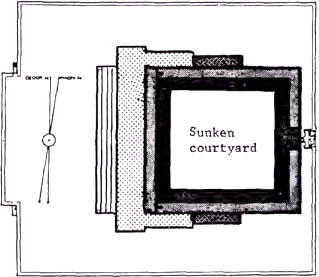
Figure 88
Of the unusual features the orbiting cameras captured on the
face of Mars, two appear to me to be almost certainly artificial—and both seem to emulate structures found on the shores
of Lake Titicaca in the Andes. One, which is akin to the Kalasasaya,
is the first feature west of the Face on Mars, just above (north of)
the mysterious darkish circle (see Plate E
above).
As an enlargement thereof indicates (Plate G below), its still-standing
southern part consists of two distinct massive walls, perfectly
straight, meeting at an angle that appears sharp because of the
photographic angle but is in fact a true right angle. The structure—which could not possibly be natural no matter how far
the imagination is stretched—appears to have collapsed, in its
northern part, under the impact of a huge boulder that dropped on it
in some catastrophic circumstances.
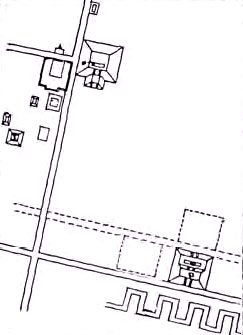
Figure 89
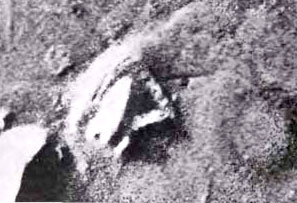
Plate G
The other feature that could not be the product of natural erosion
is found directly south of the Face, in an area of chaotic features,
some of which have amazingly straight sides (Plate H). Separated by
what might have been a channel or waterway—all are agreed that the
area was on the shores of an ancient Martian sea or lake—the
prominent feature’s side that faces the channel is not straight but
is outfitted with a series of “indentations” (Plate H).
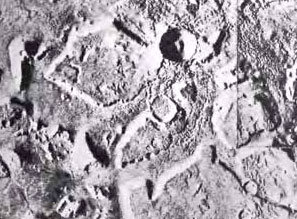
Plate H
One must
keep in mind that all these photographs were taken from an altitude
of about one thousand two hundred miles above the Martian surface;
what we observe, then, may well have been an array of large piers just as one finds at Puma-Punku.
The two features, which cannot be explained away as the result of
the play of light and shadow, thus bear similarities to the
facilities and structures on the shores of Lake Titicaca.
In this they not only support my suggestion that they are the
remains of structures put up by the same visitors—the Anunnaki—they
also offer a hypothesis for explaining their purpose and possible
function.
This conclusion is further supported by features
that can be seen in the Utopia area: a pentagonal structure
(enhanced NASA frame 086-A-07) and a “runway” next to what some deem
evidence of mining (NASA frame O86-A-O8)—Plates I and J.
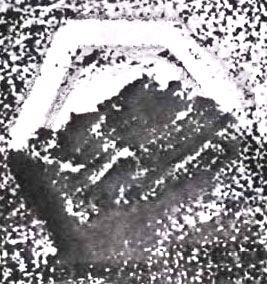 
Plate I
Plate J
The spaceports of the Anunnaki on Earth, judging by Sumerian and
Egyptian records, consisted of,
The Mission Control Center and certain
Landing Beacons were some distance away from the spaceport proper
where the runways were situated; when the spaceport was in the Sinai
Peninsula, Mission Control Center was in Jerusalem and the Landing
Beacons were in Giza, Egypt (the underground silo in the Sinai is
depicted in Egyptian tomb drawings—see vignette at end of this
chapter—and was destroyed by nuclear weapons in 2024 B.C.).
In the Andes, the Nazca lines, I believe, represent the visual
evidence for the use of that perfect, arid plain as runways for
space shuttle takeoffs and landings. The inexplicable crisscrossing
lines on the surface of Mars, the so called “tracks” (see Fig. 81)
could well represent the same kind of evidence.
There are also what appear to be true tracks on the Martian
surface. From the air they look like the markings made by a
pointed object on a linoleum floor, more or less straight
“scratches” left on the Martian plain. These markings have
been explained away as geological features, that is, natural
cracks in the Martian surface.
But as can be seen in NASA
frame 651-A-06 (Plate K), the “cracks,” or tracks, appear to
lead from an elevated structure of a geometric design with
straight sides and pierlike “teeth” on one side—a structure now
mostly buried under windblown sands—to the shores of what evidently
was once a lake.
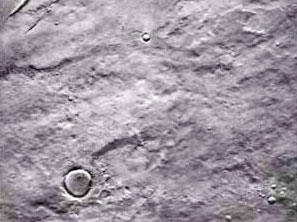
Plate K
Other aerial photographs (Fig. 90) show some tracks
on an escarpment above the great canyon in the Valles Marineris near
the Martian equator; these tracks not only follow the contours of
the terrain but also crisscross each other in a pattern that could
hardly be natural.
It has been pointed out that if an alien spacecraft were to
search for signs of life on Earth in areas of the Earth’s surface
outside the cities, what would give away the presence of intelligent
beings on Earth would be the tracks we call “roads”
and the rectilinear patterns of agricultural lands. NASA itself
has supplied what might amount to evidence of deliberate
agricultural activity on Mars.
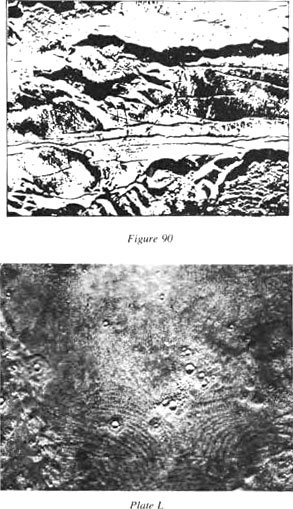
Frame 52-A-35 (Plate L) shows a
series of parallel grooves resembling contoured farmland—as one
would find in the high mountains of Peru’s Sacred Valley. The photo
caption prepared by the NASA News Center in Pasadena, California. When the photograph was released on August 18, 1976, stated thus:
Peculiar geometric markings, so regular that they appear almost
artificial can be seen in this Mars picture taken by Viking Orbiter
1 on August 12 from a range of 2053 kilometers (1273 miles).
The contoured markings are in a shallow depression or basin,
possibly formed by wind erosion. The markings—about one kilometer
(one-half mile) from crest to crest—are low ridges and valleys and
may be related to the same erosion process.
The parallel contours look very much like an aerial view of plowed
ground
meaning conveyed information regarding the named person or object.
One epithet for Mars was Simug, meaning “smith,” honoring the god
Nergal with whom the planet was associated in Sumerian times.
A son
of Enki, he was in charge of African domains that included the
gold-mining areas. Mars was also called UTU.KA.GAB.A, meaning “Light
Established at the Gate of the Waters,” which can be interpreted
either as its position next to the asteroid belt that separated the
Lower Waters from the Upper Waters, or as a source of water for the
astronauts as they passed beyond the more hazardous and less
hospitable giant planets Saturn and Jupiter.
Even more interesting
are Sumerian planetary lists that describe the planets as the
Anunnaki passed them during a space journey to Earth. Mars was
called MUL APIN—“Planet Where the- Right Course is Set.” It was so
named also on an amazing circular tablet which copied nothing less
than a route map for the journey from Nibiru to Earth by Enlil,
graphically showing the “right turn” at Mars.
Even more enlightening as to what role Mars, or the space facilities
upon it, had played in the journeys of the Anunnaki to Earth is the
Babylonian text concerning the Akitu festival. Borrowed from ancient
Sumerian traditions, it outlined the rituals and symbolic procedures
during the ten days of the New Year ceremonies. In Babylon the
principal deity who took over the supremacy from the earlier ones
was Marduk; part of the transfer of the supremacy to him was the
renaming by the Babylonians of the Planet of the Gods from the
Sumerian Nibiru to the Babylonian Marduk.
The Akitu ceremonies included a reenactment by Marduk of the voyages
of the Anunnaki from Nibiru/Marduk to Earth. Each planet passed on
the way was symbolized by a way station along the course of the
religious processions, and the epithet for each planet or way
station expressed its role, appearance, or special features. The
station/planet Mars was termed “The Traveler’s Ship,” and I have
taken it to mean that it was at Mars that the astronauts and cargo
coming from Nibiru transferred to smaller spacecraft in which they
were transported to Earth (and vice versa), coming and going between
Mars and Earth not once in three thousand six hundred years but on a
more frequent schedule.
Nearing Earth, these transporters linked up with the Earth orbiting station(s) manned
by the Igigi; the actual landing on and takeoff from Earth were
performed by smaller shuttlecraft that glided down to the natural
“runways’ “ and took off by soaring upward as they increased power.
Planners of the forthcoming steps into space by Mankind envision
almost the same sequence of different vehicles as the best way to
overcome the constraints of Earth’s gravity, making use of the
weightlessness of the orbiting station and the lower gravity of Mars
(and, in their plans, also of the Moon). In this, once again, modern
science is only catching up with ancient knowledge.
Coupled with these ancient texts and depictions, the photographic
data from the surface of Mars, and the similarities between the
Martian structures and those on Earth erected by the Anunnaki all
lead to one plausible conclusion:
Mars, some time in its past, was the site of a space base.
And there
is also evidence suggesting that
the ancient space base has been
reactivated—in our very own time, in these very days.
A DRAWING THAT DREW ATTENTION
When the Egyptian viceroy Huy died, his tomb was decorated with
scenes of his life and work as governor of Nubia and the Sinai
during the reign of the renowned Pharaoh Tut-Ankh-Amen. Among the
drawings was that of a rocketship with its shaft in an underground
silo and its conical command module above ground, among palm trees
and giraffes. The drawing, which was reproduced in The 12th Planet
together with a comparable Sumerian pictograph of a spacecraft that
designated the Anunnaki, caught the eye of Stuart W. Greenwood, an
aerospace engineer then conducting research for NASA.
Writing in
Ancient Skies (July-August 1977), a publication of the Ancient
Astronaut Society, he found in the ancient drawing aspects
indicating knowledge of a sophisticated technology and drew
attention in particular to four “highly suggestive features”:
(1)
the “airfoil cross section surrounding the rocket,” which appears
suitable for “the walls of a duct used for the development of
thrust”
(2) The rocket head above ground, reminiscent of the Gemini space
capsule even to the appearance of the windows,
(3) the charred
surface and blunt end
(4) the unusual spike, which is like
spikes tested by NASA for reducing the drag on the space capsule
without success, but which in the drawing suggests it was
retractable and thus could overcome the overheating problem that
NASA was unable to solve
(click
below image)

He estimated that,
“if the relative locations of the rocket-head and
shaft shown in the drawing are those applying during operation
within the atmosphere, the inclined shock wave from the nose of the
rocket-head would touch the duct ‘lip’ at about Mach-3 (3 times the
speed of sound).”
Back to Contents
Back to
Mars' Bases and Colonies
|
























